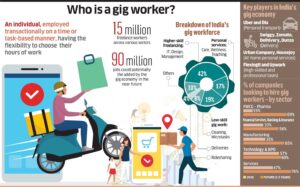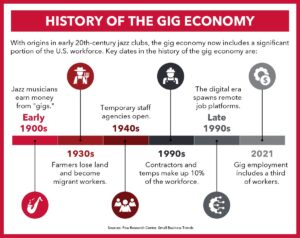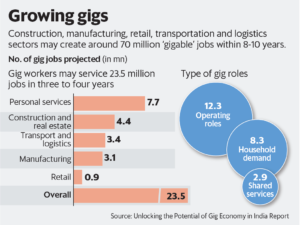Topics
- Drawn from gig workers’ struggles, hewn in Rajasthan (The Hindu)
- Moving away from the ‘take-make-dispose’ model (The Hindu)
- A women’s eye view (Indian Express)
- More capex for states (Business Standard)
- Himachal floods:a manmade disaster (The Hindu)
- Annual Economic Review a guide to 2024 growth prospects (Hans India)
Drawn from gig workers’ struggles, hewn in Rajasthan
Context:
- The Rajasthan Platform Based Gig Workers (Registration and Welfare) Act 2023 was passed in the Rajasthan Assembly on July 24, showcasing how labor law draws strength from workers’ struggles and historical victories.
- It addresses the challenges arising from the evolving employer-employee relationship in the gig economy, where workers are often deprived of basic rights and social security.

The Gig Economy and Employer Cartel:
- The term “gig” originates from jazz musicians performing short-time gigs for a fee.
- The capitalist economy applied this concept to current working arrangements, leading to the “gig economy.”
- Here, employers evade responsibility by considering workers as “partners” rather than employees, absolving themselves of obligations like fair wages, working conditions, and social security. App-based platforms, operationalized by algorithms, further perpetuate this dynamic.

The Need for Gig Workers’ Social Security:
- Gig workers face precarious working conditions and lack social security support.
- Even unions struggle to negotiate with employer cartels that control the gig economy.
- The neoliberal state has shown limited interest in supporting gig workers through legislation, leaving them vulnerable.
Drawing from Workers’ Struggles of the Past:
- The Act draws inspiration from the “Hamal model” from over 60 years ago in Maharashtra.
- The Hamal Panchayat, a union of sack-carrying workers, demanded and won a law establishing a “Mathadi board” to register workers and merchants.
- Every shopkeeper deposited a levy on every sack carried, which formed part of the worker’s wage, providing social security benefits.
- This model successfully empowered unorganized sector workers.

The Breakthrough Act in Rajasthan:
- The campaign for app-based gig workers in Rajasthan was centered around social security demands, and it resulted in the passage of the breakthrough Act.
- This Act is the first gig worker-specific social security law in India and possibly the world.
- It applies the Mathadi Act principles more accurately and efficiently due to the digital nature of platform-based gig work.
- All aggregators and workers must be registered with the board, and workers have access to their data and transactions, ensuring transparency and grievance redressal.
Implications for Fair Work and Social Security:
- The Act marks an important step towards fair work and social security for gig workers.
- It can serve as a foundation for more progressive laws in India and globally.
- Access to data and transactions empowers workers to protect their rights, and transparency in algorithms ensures better accountability.
- This Act also sets an example for handling new challenges posed by technologies like Artificial Intelligence, emphasizing the importance of democratic principles in decision-making for workers’ welfare.
Drawn from gig workers’ struggles, hewn in Rajasthan – The Hindu
Question :
What are the long-term socioeconomic implications of the gig economy’s rapid growth and its impact on traditional employment structures in various industries?
Moving away from the ‘take-make-dispose’ model

Introduction:
- Resource efficiency and circular economy are powerful strategies aimed at reducing dependence on natural resources, minimizing waste generation, and promoting sustainable design practices.
- These approaches are crucial in achieving sustainable development and the Sustainable Development Goals (SDGs) worldwide.
- Decoupling resource utilization from economic growth is considered key in this global endeavor.
India’s Prioritization in G-20:
- India has identified “Resource Efficiency and Circular Economy” as one of the core themes for discussions within the G-20 forum.
- The country has embraced four priority areas for the circular economy during its G-20 presidency:
- Circularity in the steel sector,
- Extended Producer Responsibility (EPR),
- circular bioeconomy, and
- establishing an industry-led resource efficiency and circular economy coalition.
Transitioning to a Circular Steel Sector:
- Most G-20 member countries have committed to net-zero ambitions and are working to reduce greenhouse gas emissions.
- To ensure responsible resource consumption, the current recycling rates of 15%-25% need to be raised.
- As steel plays a crucial role in infrastructure development, its efficient utilization is essential.
- Collaborative efforts among G-20 countries are crucial for knowledge sharing, technology co-development, and technology transfer to transition to a circular steel sector.
Extended Producer Responsibility (EPR):
- India emphasizes the significance of the EPR framework in integrating circularity throughout the value chain.
- Sharing best practices among G-20 member countries can accelerate the transition to a circular economy.
- India has one of the largest EPR frameworks, with comprehensive rules for e-waste and battery waste management.
Recycling, Bioeconomy, and Biofuels:
- Effective implementation of EPR promotes the growth of recycling infrastructure and streamlined waste collection systems.
- Biological waste, such as municipal and industrial waste and agricultural residue, has become a global issue.
- Adopting a circular bioeconomy approach can reduce the need for extracting virgin resources and provide an effective waste disposal solution.
- India has been actively promoting biofuels through various schemes, encouraging sustainable agriculture and reducing pollution.
Industry Coalition:
- Recognizing the importance of industries in driving resource efficiency and circular economy practices, India envisions an industry coalition.
- This coalition aims to foster technological collaboration, build capabilities across sectors, mobilize de-risked finance, and encourage private sector engagement.
The Role of G-20:
- Global platforms like the G-20 play a vital role in addressing key challenges and presenting solutions through collaboration.
- Resource efficiency and circular economy strategies have emerged as promising pathways in tackling planetary challenges.
- India’s G-20 presidency has significantly focused on resource efficiency and circular economy approaches, offering a promising direction toward a sustainable and resilient future. These efforts exemplify the importance of international collaboration in promoting sustainable development and mitigating environmental impacts.
Moving away from the ‘take-make-dispose’ model – The Hindu
A women’s eye view
![]()
Context:
The last 75 years have seen both celebration and degradation of Indian women. The poem ‘There are no honest poems about dead women’ by Audre Lorde raises a crucial question for today’s times: What do women want after they have told all their stories? Should they focus on individualistic storytelling or work towards a collective movement to reshape democratic India?
The Dominance of the Male Viewpoint in Manipur:
- In Manipur, a matriarchal past is overshadowed by male dominance in politics, administration, and law.
- Visuals of Meitei men mistreating Kuki girls highlight the need to challenge present laws shaped from male perspectives and adjudicated mostly by male judges, perpetuating inequality.
The Need to Address Systemic Inequality:
- True gender equality can only be achieved by addressing systemic inequality in India.
- Sexual abuse remains a major factor that perpetuates women’s vulnerability and limits their opportunities, including low-paying jobs.
- Discussions on important laws like the uniform civil code should include women representatives who can claim women’s experiences as legitimate.
Overcoming Discrimination and Biases:
- Despite legal provisions, women face discrimination in property rights, control over their own bodies, and custody of their children.
- The legal process often proves slow and biased against women, hindering justice and reinforcing gender-based power imbalances.
Hope for Change and Sensitivity in the Legal System:
- With a Chief Justice showing sensitivity to women’s vulnerabilities, there is hope for change.
- However, a collective movement supported by the apex court is essential to ensure equal rights for all women, including those in working-class professions.
Conclusion:
Reimagining India at 100 requires a shift in societal attitudes and a collective movement to challenge systemic inequality.
Women’s experiences and perspectives must play a central role in shaping a new theory of the state that upholds the principles of democracy and recognizes the intrinsic humanity of women.
Only then can the nation progress with love, tenderness, and true equality for all.
More capex for states
![]()
Context
- Budgets have been characterized by a consistent increase in the government’s capital expenditure.
- This key feature reflects a commitment to upgrading the country’s infrastructure and encouraging private sector investment.
- The government’s capital expenditure as a percentage of GDP has steadily risen in recent years.
Rising Capital Expenditure:
- In 2019-20, the government’s capital expenditure was about 1.67% of GDP.
- The share increased to 2.15% of GDP in 2020-21, 2.53% in 2021-22, and further to 2.67% in 2022-23.
- The current financial year’s budget aims to raise it to 3.3% of GDP, crossing the 3% mark last seen in 2004-05.
Commitment to Infrastructure Upgrade:
- The Finance Minister’s decision to prioritize higher capital expenditure over a lower fiscal deficit number demonstrates her commitment to improving infrastructure and boosting private sector investment.
- This increase in government capex has been the sharpest rise in any five-year period in many years.
Change in Capital Expenditure Composition during Post-Pandemic Years:
- During 2021-22, a small portion of the capex allocation (~10,000 crore) was disbursed to states as a 50-year interest-free loan for capex, contingent on certain economic policy reforms.
- In 2022-23 and 2023-24, a little over 13% of the total Central capex went to the states for their capex projects.
State Capital Expenditure Response:
- Despite receiving only ~10,000 crore from the Centre in 2021-22, the capital expenditure by most states rose significantly by about 32% from the previous year.
- However, in 2022-23, when the Centre offered ~1 trillion as capex support, the states’ capex increased only by ~66,000 crore, with some states even witnessing a decline in their capital outlay.
- Potential reasons for slow capex growth include reduced urgency to create jobs due to the pandemic’s decline, a shortage of executable projects, or diversion of resources for other schemes under revenue expenditure.
Challenges and Concerns:
- The slow capex growth for states in 2021-22 despite increased Central support raises concerns about the nature of assistance and policy steps required to sustain the rise in capital expenditure.
- States’ absorptive capacity to implement capital projects is a cause for concern, and addressing administrative hurdles is challenging.
- There are worries that some states might divert Central funds meant for capital expenditure to fund other populist schemes.
Conclusion:
Finance Minister Nirmala Sitharaman’s Budgets have seen a significant rise in government capital expenditure, focused on upgrading infrastructure and encouraging private sector investment.
However, challenges persist in ensuring effective utilization of funds by states and preventing misuse of Central funds for purposes other than capital projects. Sustainable growth in state capital expenditure requires careful planning and execution.
https://www.business-standard.com/opinion/columns/more-capex-for-states-123072500951_1.html
Himachal floods: a manmade disaster

Context:
During this year’s monsoon season, Himachal Pradesh experienced flash floods that caused significant damage to both lives and assets. The death toll exceeded 150, and the estimated loss amounted to ₹10,000 crore.
While climate change likely contributed to the high precipitation leading to these floods, human-induced disasters resulting from unplanned development also played a significant role in causing massive losses.
Climate Change and Increased Precipitation:
- The Intergovernmental Panel on Climate Change (IPCC) VI report highlights that the Himalayas and coastal regions of India will be hardest hit by climate change.
- In the Himalayas, there is an observable pattern of increased precipitation occurring in shorter periods.
- Normal rainfall during the monsoon season is expected to be between 720mm and 750mm, but instances of exceeding 888mm (2010) and 926.9mm (2018) have been recorded.
- This year’s rainfall has been attributed to the combined effect of the south-west monsoon and western disturbances.
Development Model Impact:
- Himachal Pradesh’s development model, known as the Dr. Parmar model, initially focused on land reforms, state-led investment in social welfare, and emphasis on human resources.
- However, liberalization led to changes, with the State forced to generate its resources for fiscal management.
- This resulted in the rapid construction of hydropower projects, road widening, cement plants, and shifts in agricultural practices, which significantly affected the landscape and river systems.
Uncontrolled Hydropower Projects:
- The pursuit of hydropower projects has transformed mountain rivers into mere streams.
- The technology used diverts water through tunnels, and the excavated material is often dumped along riverbeds.
- During periods of heavy rain, the water carries the dumped material, causing damage.
- The region currently has 168 operational hydropower projects generating 10,848 MW, with plans to commission 1,088 projects generating 22,640 MW by 2030, raising concerns about impending disasters.
Impact of Tourism-driven Road Expansion:
- Road widening projects aimed at promoting tourism have bypassed essential geological studies, leading to vertical cutting of mountains.
- This results in landslides and damage to roads during even normal rainfall, amplifying destruction during heavy rains or floods.
Cement Plants and Altered Landscapes:
Massive cement plants in various districts have altered the landscape, reducing the land’s capacity to absorb water and contributing to flash floods.
Shift in Crop Patterns:
- A shift from traditional cereal farming to cash crops has led to hasty road construction without proper drainage or designated areas for dumping muck.
- Water finds its own path, carrying dumped material and depositing it into the river ecosystem, causing swelling even during normal rainfall.
Way Forward:
- Establishing a Commission of Inquiry involving the people can address policy framework failures and unique project aspects.
- Empowering local communities and insuring assets can help compensate for losses and rebuild infrastructure quickly.
- Adequate changes in infrastructure planning are necessary to avert disasters in the face of climate change.
Conclusion:
The flash floods in Himachal Pradesh have been influenced by both climate change-induced high precipitation and unplanned human development activities. Addressing these issues requires a collaborative effort, incorporating sustainable development practices and empowering local communities to mitigate and adapt to future challenges.
Annual Economic Review a guide to 2024 growth prospects
![]()
Introduction
The Annual Economic Review 2022-2023, released by the Union Finance Ministry, showcases India’s remarkable economic performance and recovery from the pandemic-induced challenges.
With a GDP growth of 7.2 per cent, surpassing estimates, and a strong focus on government-led capital expenditure, the report highlights positive trends in various sectors, including exports and job creation.
Despite inflation concerns, the stable financial sector and prudent fiscal management position India on a path towards achieving its ambitious goal of becoming a five trillion-dollar economy.
- Strong Economic Performance:
- India’s Annual Economic Review 2022-2023, released by the Union Finance Ministry, highlights the country’s substantial economic growth compared to other nations.
- The GDP for 2022-23 reached 7.2 per cent, surpassing the estimated level of seven per cent, despite challenges faced during the last quarter.
- Recovery from the Pandemic:
The report acknowledges the significant recovery from the negative growth of 5.8 per cent in 2020-21 and the subsequent low growth of 3.9 per cent in 2019-20, which occurred before the COVID-19 pandemic hit.
- Government-led Capex:
- The government has played a crucial role in driving growth through capital expenditure (capex) projects.
- It has increased allocation to fresh capex and provided long-term funds to states, resulting in a 10-year high share of Gross Fixed Capital Formation (GFCF) in GDP.
- Growth Drivers:
- The consistent growth of the agricultural and services sectors has been key drivers in sustaining the current momentum of growth.
- The manufacturing sector’s contribution to GDP has remained constant, while private sector investment declined in 2020-21.
- Exports and CAD:
- India has performed well in merchandise and service exports, supported by a decline in global commodity prices.
- The report suggests that the Current Account Deficit (CAD) remains sustainable due to remittances from Non-Resident Indians (NRIs) and normal capital flows.
- Job Creation and Employment:
The manufacturing and services sectors have shown rising job creation, particularly in sub-sectors like electronics, auto, auto ancillary, insurance, hospitality, and banking.
- Inflation Outlook:
- CPI inflation has increased slightly, but globally, inflation outlooks have been on the decline for 2023.
- The Reserve Bank of India (RBI) is committed to bringing inflation below four per cent.
- Positive Economic Factors:
- The report highlights positive factors like prudent fiscal management, good current account position, increasing foreign exchange reserves, manageable inflation, steady rupee, and a positive outlook on India’s service exports, contributing to the growth prospects for FY 2024.
- Growth Projections:
- Amid a lower global growth projection of 2.1 per cent for 2023, India’s growth is projected at 6.5 per cent for 2023-24.
- The financial sector’s strength and credit growth between 15 to 16 per cent should aid economic development.
- Journey Towards a Five Trillion Dollar Economy:
With stable macroeconomic conditions and a strong financial sector, India is on track towards achieving its goal of becoming a five trillion-dollar economy sooner than later.
Conclusion
THE Annual Economic Review 2022-2023 demonstrates India’s robust economic performance, recovery from the pandemic, and positive growth outlook for the future, supported by government-led initiatives, strong exports, and a thriving financial sector.

